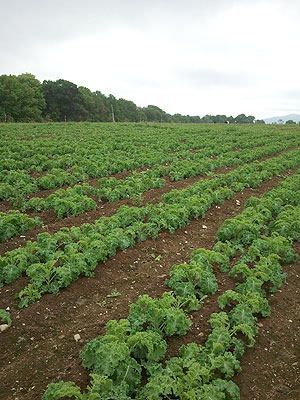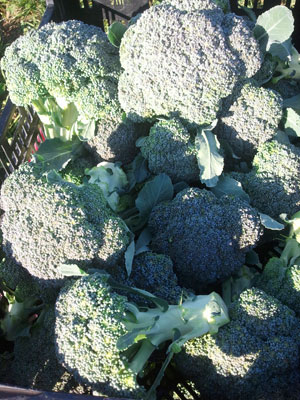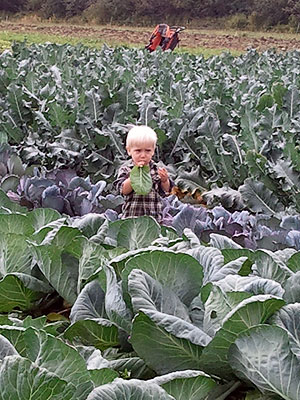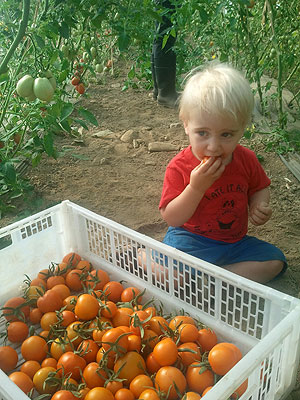By Holli Cederholm
Like many small- to mid-scale certified-organic vegetable farms, Ararat Farms in Lincolnville, Maine, aims to provide quality, healthy products to the surrounding community. Farm managers Emilia Carbone and Jed Beach have an additional goal: They want their produce to outshine the standard grocery store vegetables in terms of flavor, nutrient density and shelf life.
Early on, the pair decided to tailor their market strategy toward wholesale rather than retail, based on the hypothesis that the expansion of local food sales ultimately relies on access. “The direct market for organic foods may be finite,” Beach writes in the November 2010 MOFGA publication “Maine’s Organic Farms: An Impact Report.”
The report, based largely on the 2007 Census of Agriculture, suggests that consumer shopping habits cap the growth of the direct market sector for locally produced organic goods. Only 12 percent of Maine’s families were deemed locavores (those who specifically seek locally grown food), while 43 percent are more casual consumers of local farmers’ fare. The rest of Maine favors the familiar – their area grocery store.
Beach summarizes that 6 to 8 percent of any community is committed to a local farmstand or Community Supported Agriculture (CSA) farm. “Convenience was the most important determining factor for buying local food,” says Beach.
Beach and Carbone decided to cater to these Maine market trends. “We founded our business plan on the idea that we could reach that group,” says Beach.
 |
| Ararat Farms’ produce stands out with consistent labeling and colorful cultivars. |
A Different Strategy
In 2011, their first year on the ground in Lincolnville, Carbone and Beach grew a diverse spread for landowner Dr. Garo Armen’s family table, as well as their own, and sold the surplus. As Beach relays, Ararat Farms started with the well-known market model in which small farms peddle most of their produce directly to customers at a premium price and subject only their bumper crops to the lower wholesale margin.
“In 2012 we decided to invert that,” Beach says. They increased their area in cultivation from 1 to 5 acres and streamlined their crop plan to a few favorites that perform well on their farm.
“With wholesale we want large amounts of a few crops,” says Carbone.
They focused on eight – kale, salad mix, Asian greens, cabbage, onions, beets, carrots and broccoli – to have consistent offerings of the same quality products week after week.
“We’re slowly but surely finding our niche in the world … by being really consistent with them,” says Beach.
The pair credits part of their strategy to landowner Dr. Armen’s influence. His work as a cancer researcher and his subsequent commitment to a plant-based diet reinforces the couple’s own philosophies founded in healthy soil and the resulting healthy crops. Armen’s business acumen also provides a solid sounding bound for the farm’s expansion. Carbone says, “We work together to figure out where we’re headed and make decisions.”
Their 2012 offerings were available directly from the farm through their physical farmstand on Vancycle Road in Lincolnville, and through their online farmstand – a virtual shopping portal where customers can pre-select their vegetables for pick-up in Camden at one of the farm’s wholesale clients, State of Maine Cheese Company. The bulk of their harvest stocked the shelves of area stores, including Fresh Off the Farm, the Belfast Co-op, the Good Tern Co-op, and select midcoast Hannaford stores.
The Wholesale Experience
Carbone and Beach are no strangers to direct marketing: They spent five years managing a nonprofit CSA farm in Massachusetts before returning to their home state and undertaking the management of Ararat Farms.
 |
| Green kale bunches were one of the first products that Ararat Farms supplied for midcoast Hannaford stores. |
 |
| Broccoli is one of the eight crops that Ararat Farms grows for wholesale markets. |
Carbone relates that dealing with CSA customers is entirely different from wholesale clientele. The former expects a diverse product line and some basic education; the latter needs reliable service and a regular product. With all their wholesale accounts, Ararat Farms mimics the routine of a national produce distributor, with usual phone or email check-ins, scheduled delivery days and times, and consistent, standardized product.
Some larger grocery chains, such as Hannaford, also require Good Agricultural Practices (GAP) certification. Knowing they wanted to move in this direction, Ararat became GAP-certified for leafy greens in spring of 2012. “We feel like this is the next frontier,” says Beach.
A lot of the practices that GAP dictates are common sense, says Carbone. Employee sanitation is just part of GAP certification. Other components include a food safety plan, measures for deterring wildlife, and “a fair amount of record keeping.” Lot numbers for traceability in case of a recall are just one example.
Before GAP certification, farms are subject to two inspections, one scheduled and one surprise. Costs of certification relate to scale; Ararat’s inspections averaged $600 each.
Additional costs are related to a certifiable packaging station, which is not yet a requirement for Hannaford. However, Ararat Farms built its new facility to code, with a washable floor and walls, floor drain, closed lights and a separate sink for hand washing.
Carbone and Beach are glad they certified. “GAP certification is far more achievable than people think,” says Beach.
Carbone adds that it’s a matter of size. “You have to be larger scale to really make it work.”
Hannaford How-to
Adding Hannaford to their marketing plan was an obvious next step for Ararat Farms. In scouting the produce department, they noticed that local offerings were sparse and the quality of organic crops comparable to their own was sub-par. The higher sticker prices on organic goods translated into a doable margin for the farm.
Access, of course, was another draw. “They’re a near monopoly in most areas of the state,” says Beach. Carbone adds that their other wholesale clients, natural food stores, serve only a fraction of the population.
A farm can get its products onto Hannaford shelves in one of two ways: by dealing directly with the distribution headquarters in Scarborough or by forming relationships with produce managers at individual Hannaford stores.
Carbone and Beach decided to work with the Belfast, Camden and Rockland stores, but will switch gears in 2013. Carbone says that the managers they worked with were great, but the farm’s overall sales were inconsistent based on who answered the phone.
It’s much easier for the produce managers to order from the Scarborough warehouse, says Beach.
Either route still requires that growers register the items they wish to sell in the supermarket’s point-of-sale system, so each product needs a bar code.
In its first season working with Hannaford, Ararat decided to market items already in the store’s system. This meant Ararat couldn’t offer ‘Red Russian’ kale, as Hannaford had only green kale registered; or parsley bunches, because Hannaford didn’t stock organic parsley.
Registering an item in the point-of-sale system can take up to four weeks, so Carbone and Beach initiated the process last winter.
They have been considering other ways to improve this wholesale experience, such as how to further distinguish their products from those being trucked from away.
 |
| Ray taste-tests collards … |
 |
| and tomatoes. |
Quality First
One disadvantage to wholesale marketing is that, unlike the farmer at the local market, Beach and Carbone are not in the Hannaford aisle talking up the ugliness of an heirloom tomato in relation to taste, or how children eat colored carrots like candy. In the absence of that face-to-face exchange, Ararat’s produce must speak for itself.
“It’s not enough to get the product in there. It takes more,” says Beach.
Some of their silent marketing tactics include branding their farm with consistent product labeling and choosing to grow more colorful vegetable cultivars. They’ve learned a lot from their trial year stocking Hannaford’s shelves. Their multi-colored beet bunches sold better than their kale bunches – a fact they attribute to visibility.
“Our green kale got lost in their giant wet wall,” Beach says.
In 2013, the farm will increased to 10 acres in cultivation, including an increased product line-up that caters to absences in Hannaford’s local offerings: baby rainbow carrots, mixed cherry tomatoes, and a tender, colored kale mix. Each will be packaged in plastic clamshells, specific to the grocery chain’s marketing preferences.
Another selling point of Ararat Farms’ produce is its high level of quality control. “We want everything that comes out of the box to be something we’re proud of,” he says.
Their standards start with flavor. As a crop is nearing harvest, Carbone and Beach take brix readings with a refractometer or do their own taste tests. Brix is a numerical assessment of plant nutrient density that Carbone and Beach can compare with USDA averages, thus showing that Ararat Farms’ produce is of a higher quality than the imported competition.
“The qualitative flavor check is faster and, although subjective, is pretty effective,” says Beach. Carbone adds that their 2-year-old son, Ray, often detects the starch-to-sweet flavor conversion in greens with the onset of cooler weather before they do.
Ararat Farms also has strict visual standards. The harvest crew is trained to select the most vibrant leaves, devoid of insect damage, for their kale bunches, and to account for uniform size and weight. Every root bunch or batch of greens mix is visually inspected again by the washing crew before a final inspection during packaging.
Much like a sous-chef at a fancy restaurant, the washer brings the produce up to the “pass.” At Ararat Farms, it’s a window between the wash and pack rooms in the packaging facility.
“The overarching concept is that we’re really focused on quality,” says Beach. “It’s what sets us apart from imported California kale.”
“We’re not trying to compete with other farms, we’re trying to help this movement,” says Carbone. Beach adds, “We’re trying to replace the product from away.”
About the author: Holli Cederholm was a MOFGA farmer-in-residence, with Brian St. Laurent. Their Proud Peasant Farm is now located in Washington, Maine.

